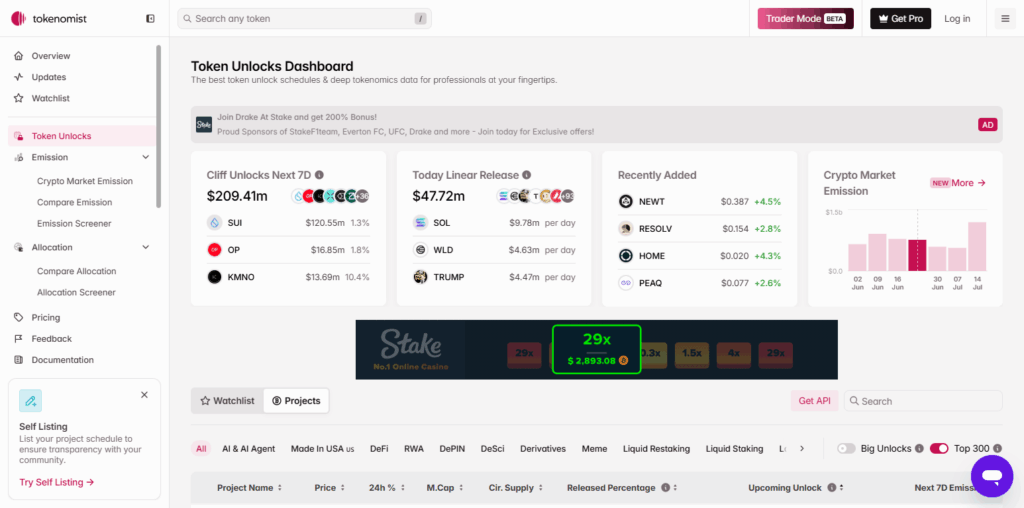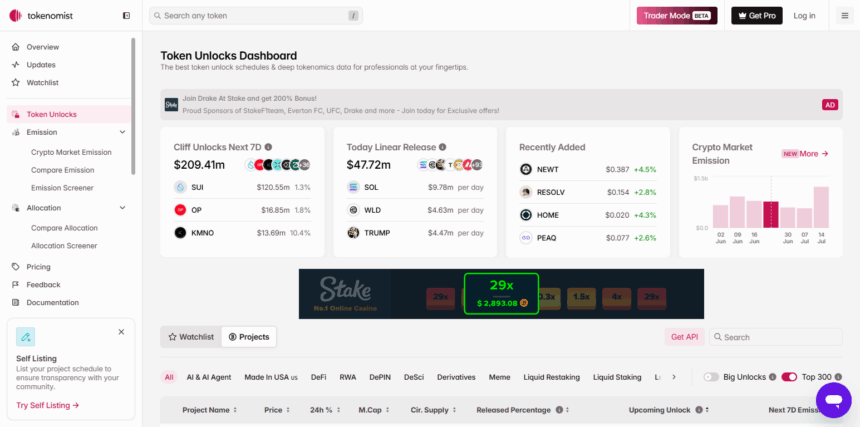In this article I will talk about what a token unlock is and why it is considered important in cryptocurrency. A token unlock refers to the scheduled release of previously locked tokens, usually held by teams, investors or advisors.
Understanding how token unlocks work helps market participants strategically position themselves before major events and assess a project’s longevity and sustainability.
What Is a Token Unlock?
A token unlock is the scheduled release of a cryptocurrency project’s tokens which were previously locked and could not be traded or transferred. These tokens are meant for allocation to team members, advisors, early investors, or formed as ecosystem funds and are distributed gradually based on a vesting schedule.

This process is normally part of the smart contract of a token and is very common in initial coin offerings (ICOs), token generation events (TGEs), or launchpads. This is designed to curb massive sell-offs post-launch and assure stakeholders remain engaged long-term.
Why Are Tokens Locked?
Prevent Market Dumping
To prevent the project from being market-dumped by early investors or insiders, there is a restriction on how quickly these parties can trade their tokens; otherwise, the token’s value would crash.
Promote Long-Term Commitment
In order to encourage sustained participation from team members and advisors, their tokens need to be locked and only partially released over time. This approach fosters long-term commitment aligned with the project’s growth.
Investor Confidence
Retail investors feel safer knowing there are not any quick sells waiting to be claimed because other locked periods have shown that the team is interested in making profits through sustained effort.
Control Token Supply
Controlled circulation can also ensure there is a strong balance of issuance and inflation. A methodical release helps manage circulation and establishes equilibrium between demand and inflationary pressures.
How Does a Token Unlock Work?
Token unlocks are usually managed according to a vesting schedule. A timeline determines how and when locked tokens will be made available. Vesting schedules differ from project to project, but they generally fit one of the following types:
- In Cliff Vesting, tokens become accessible only after an initial waiting period (for example six or twelve months).
- In Linear Vesting, tokens become progressively accessible over a given time frame (for example 25% every 6 months).
- Hybrid Vesting: This is a combination of cliff and linear methods. For instance, 25% released after 6 months.
These policies are enforced by the issuing smart contract which guarantees compliance without any possibility of tampering or intervention.
Who Receives Locked Tokens?
Usually, locked tokens are allocated to the project’s founders, team members, advisors, private sale investors, and ecosystem or treasury funds. They receive these tokens as part of compensation packages, early investment contracts, or in return for aids they provide towards a project’s long-term development goals.
Each category usually follows different vesting schedules aimed at maintaining commitment and reducing the risk of instant sell-off which would contribute towards destabilizing the token’s price or undermine support for the project.
Why Does Token Unlocks Impact The Market Activity?

Impact on Price:
As the demand for tokens increases and certain verifiable figureheads or institutions come forward to back the project — panic buying is triggered which makes investing during periods of downturn highly beneficial.
Market 702 Sentiment
The trading enables traders to quickly and efficiently respond to changes in real-time events that happen with a slight indentation around predetermined deadlines.
Unlock Opportunities
Specific trades on specific dates can make a positive mark on the project under negotiation depending on its trade enabling policies at given timestamps.
Evaluation Opportunity
A trader’s smart man up strategy when carried out alongside other techniques such as risk reduction interoperates rewards growth at economical constant rates unprecedented levels
Conclusion
To sum up, every modern crypto project employs token unlocks for managing supply, incentivizing various stakeholders and ensuring sustainable growth.
While there are reasons to have them, they can also be particularly risky to short-term traders who do not track the timing and scale of upcoming unlocks.
Knowing what a token unlock is and when it happens will greatly aid you in maneuvering through the crypto markets. As always, do your research uncover unlock timelines and employing risk management protocols tailor to what you find.
FAQ
Who gets locked tokens?
Locked tokens are usually given to founders, team members, advisors, early investors, and ecosystem funds.
How are tokens unlocked?
Tokens unlock gradually over time through a vesting schedule, often managed automatically by smart contracts.
What is a vesting schedule?
It’s a plan that releases tokens in parts over time, such as monthly, quarterly, or after a “cliff” period.










